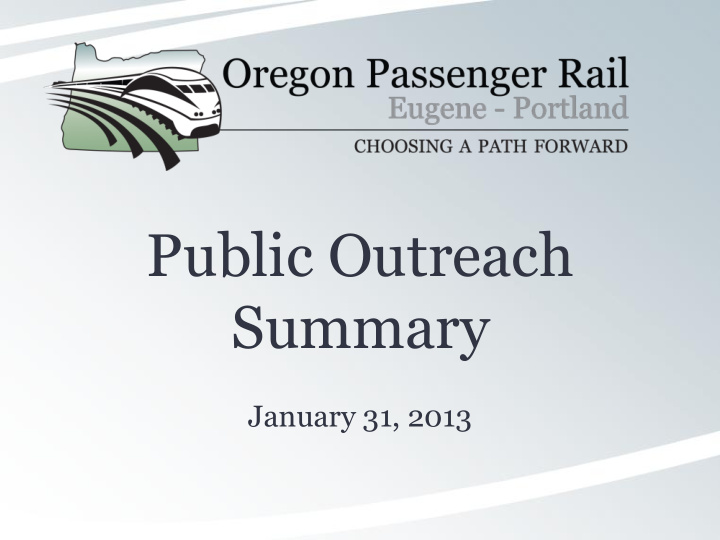



Public Outreach Summary January 31, 2013
Open House Events • Six open house events in January: Albany, Oregon City, Portland, Salem, Springfield, Tualatin • Total of 330 attendees at the events • 160 comment forms were submitted • 231 participants in the Goals Prioritization activity
Open House Events Online Participation: • 1,200 unique visitors to the open house • 145 map comments • 187 online comment forms have been submitted • 103 goal exercise entries Milwaukie Briefing: • 58 people attended a community briefing in Milwaukie
Goals & Objectives: public input • Most comments supported or stressed importance of certain goals. • Few or no comments made to add or significantly alter any of the goals. • Mix of support for a long-term high speed vision vs. making incremental improvements to the current system now. • Reliability and frequency of service are most important, with better coordinated travel times to meet traveler needs.
Goals & Objectives: public input Continued… • Passenger rail must connect well to local transit in order to be viable. • Rail improvements should promote economic development and protect existing investments. • Some concern of burden on local taxpayers and subsidized rail system. • Passenger rail should serve the highest population centers.
Goals Exercise Results 770 Number of responses 574 439 383 377 349 336 Goal 1 Goal 2 Goal 3 Goal 4 Goal 5 Goal 6 Goal 7 mobility & protect cost- affordability & compatibility community protect accessibility freight-rail effectiveness equity with health & environment Washington quality of life Goals
Objectives: public input • Open house participants chose the seven objectives they felt were most important. • The most highly ranked include: – 1B – Provide reliable and frequent passenger rail service. (74%) – 1A – Provide a viable alternative to auto, air, and bus travel between Eugene, OR and Vancouver, WA. (73%) – 5A – Provide passenger rail service to meet the existing and future passenger rail demand for an interconnected system in the PNWRC. (65%)
Screening: public input • 79% of participants said that they agree with the preliminary results of the corridor concepts screening. • Very few comments suggesting that any screened out alternatives be reconsidered. • Stations: – Support for existing stations, serving downtown centers, and linking with local transit. – High support for new station in Corvallis, and some support for new station in Woodburn. High support to maintain Oregon City station.
Screening: public input • Blue (existing UP) Alignment – Most supported with very few negative comments. – Support for using existing resources. • Red (I-5) Alignment – Mix of positive and negative comments. – Comments that this would allow for true-high speed rail, and minimize community/environmental impacts. – Concern that this would be too expensive and disrupt vehicle traffic.
Screening: public input • Purple (OE) Alignment – Split support; about half support and half do not support OE line. – Concern about community impacts on Milwaukie, Tualatin and Lake Oswego. – More support for southern portion (Eugene to Albany or Salem). – Support for using state-owned right of way. • Yellow (west) Alignment – Mostly positive support for the southern portion (Eugene to Corvallis/Albany).
Goals Exercise: Corridor Forum 29% 24% Number of Responses 18% 15% 14% 14% 13% 12% 12% 12% 12% 11% 10% 7% Goal 1 Goal 2 Goal 3 Goal 4 Goal 5 Goal 6 Goal 7 mobility & protect cost- affordability & compatibility community protect accessibility freight-rail effectiveness equity with health & environment Washington quality of life Goals
Goals: Corridor Forum Input • Discussion following exercise: – Compared to public: Freight higher; Environment and Affordability lower. – Environment, low because regulations will be followed regardless; should it be higher? – Freight: rail owners will protect anyway; should it be lower? – Should the weighting reflect the difference the goal would make or the importance of that value overall?
Local Discussions: Corridor Forum Input • Have local business and economic development at the table • Station locations all need local discussion • Tap into existing groups • Small cities need to see benefits if no station; at least provide connectivity to rail • Community Advisory Groups will be an important education opportunity as well as input gathering
Local Discussions: Corridor Forum Input Eugene/Springfield, Lane County • Eugene/Springfield CAG , sample issues : – Station location(s) – Crossing the Willamette – Alignment to meet future ridership • Work separately with small cities – Safety • Need info on value/impacts of going to Corvallis
Local Discussions: Corridor Forum Input Albany/Linn County • One CAG for Albany/Corvallis? – Station – Increased crossing challenges if it goes through Corvallis – Transit service to make connections • Small city forum – High speeds division of communities and impact on transportation system – Connection to stations
Local Discussions: Corridor Forum Input Salem to Woodburn • One CAG for Salem/Keizer , sample issues : – How it goes through neighborhoods and by schools – Station location – Quiet zones • Potential CAG for Woodburn area &/or City Council – Potential for future station – Crossings and/or elevated section
Local Discussions: Corridor Forum Input Portland Metro area , sample issues : • Clackamas County , address gap in participation particularly regarding I 205-based options • Community groups already sensitive to rail • Potential CAG: Hayden Island/West Hayden Community, c rossing the Columbia • Getting through south Metro area to Downtown (CAG? Existing groups?)
Next Corridor Forum Meeting Date: March 6 th (Location TBD) Purpose: Corridor Forum will weight the objectives to be used for the evaluation
Recommend
More recommend